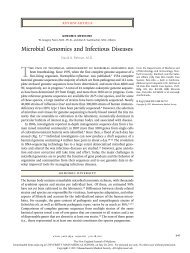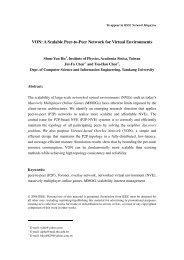3.1 MB - Evernote
3.1 MB - Evernote
3.1 MB - Evernote
You also want an ePaper? Increase the reach of your titles
YUMPU automatically turns print PDFs into web optimized ePapers that Google loves.
92<br />
Validation of the Parallel Simulator<br />
As a result of the changed GENERATE block configuration and the first partition being<br />
ahead of the second partition in simulation time, all Transactions received by partition 2<br />
from partition 1 are in the future for partition 2 and no rollbacks will be caused. But it<br />
will lead to an increase of the number of outstanding Transactions within partition 2<br />
pushing up the number of uncommitted Transaction moves during the simulation.<br />
The logging configuration for this validation is also similar to the one used for<br />
validation 5 except that the LP statistic is not needed this time and is therefore switched<br />
off. The extract below shows the loggers for which debug output was enabled.<br />
…<br />
log4j.logger.parallelJavaGpssSimulator.lp=DEBUG<br />
log4j.logger.parallelJavaGpssSimulator.lp.commit=DEBUG<br />
log4j.logger.parallelJavaGpssSimulator.lp.rollback=DEBUG<br />
…<br />
log4j.logger.parallelJavaGpssSimulator.lp.lpcc=DEBUG<br />
log4j.logger.parallelJavaGpssSimulator.lp.lpcc.statespace=DEBUG<br />
log4j.logger.parallelJavaGpssSimulator.simulation=DEBUG<br />
…<br />
Extract of the used log4j configuration file proactive-log4j<br />
Like for validation 5 the script startNode.sh used to run the LP nodes is changed to<br />
extend the memory limit of the JVM to 128<strong>MB</strong>.<br />
Validation 6.1<br />
For the first validation run the LPCC was enabled using the same configuration like for<br />
validation 5.1 resulting in the model being simulated using the Shock Resistant Time<br />
Warp algorithm. The significant effect of the simulation run is that the LPCC in LP2<br />
starts setting actuator values in order to steer the local simulation processing towards a<br />
state that promises better performance but because the number of uncommitted<br />
Transaction moves within the second partition increases as a result of the Transactions<br />
received from partition 1 the actuator limits set by the LPCC are reached and the LP is<br />
switched into cancelback mode leading to its simulation progress being slowed down. In<br />
addition LP1 is also slowed down by the Transactions cancelled back from LP 2 as<br />
indicated by the output log of LP1. The actuator being set for LP2 can for instance be<br />
seen in line 25 to 28 of the output log of LP2. Subsequently the actuator limit is reached
















